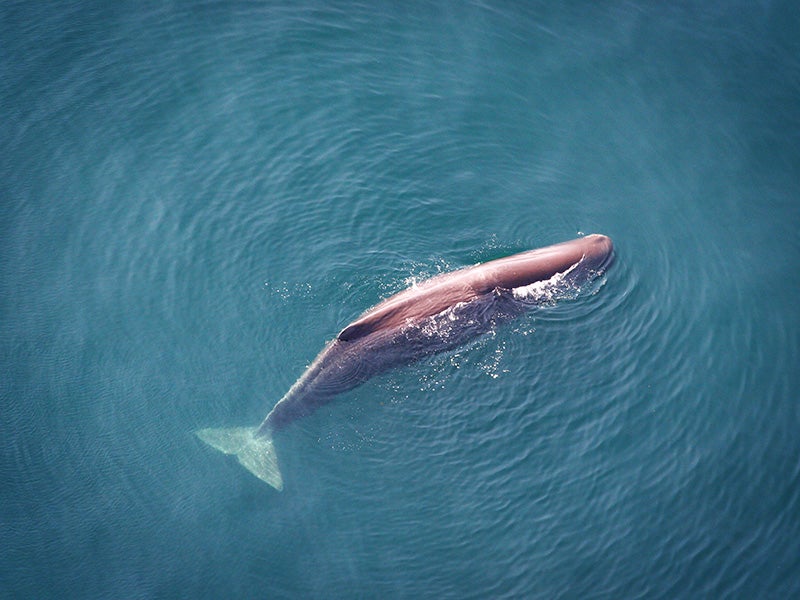Feds Find Oil, Gas Seismic Surveys in Gulf of Mexico Would Harm or Harass Marine Mammals up to 31.9 Million Times
The new report acknowledges what environmental groups have long warned
Contact
The Bureau of Ocean Energy Management has released a draft environmental impact statement that concludes seismic surveys for oil and gas exploration in the Gulf of Mexico would cause significant harm to marine mammals. The long-awaited review comes in response to a court-ordered settlement of a lawsuit brought by environmental groups.
BOEM
Gulf of Mexico, Outer Continental Shelf. Geological & Geophysical Programmatic EIS, Area of Interest. (View Larger)
The analysis finds that as many as 31.9 million marine mammals in the Gulf of Mexico will be injured and harassed by oil and gas seismic surveys. This includes 80 percent of the Gulf’s endangered sperm whale population, estimated at 763 animals. Sperm whales will experience as many as 760,000 harassing exposures to airgun blasting over the next decade.
The draft estimates that seismic blasting would cause as many as 588 injuries to the Gulf’s Bryde’s whales—of which only 33 individuals remain—or about 17 times for each member of this imperiled population.
“For years, industry has been allowed to blast away without permits, without authorizations, and without thought about how its activities are degrading the already beleaguered Gulf,” said Michael Jasny, director of NRDC’s Marine Mammal Protection Project. “This place is not a sacrifice zone. The federal government finally needs to take action once and for all and not condone this business-as-usual disregard for the health of these waters.”
Seismic exploration surveys use extensive arrays of high-powered airguns to search for oil. These generate the loudest human sounds in the ocean short of explosives. The blasts, which can effectively reach more than 250 decibels, can cause hearing loss in marine mammals, disturb essential behaviors such as feeding and breeding over vast distances, mask communications among whales and among dolphins, and reduce catch rates of commercial fish.
The new report finally acknowledges what environmental groups have long warned: that these sonic blasts cause harm to marine mammals. The report estimates that oil and gas seismic surveys will harm whales and dolphins with as many as 4.3 million instances of injury, including permanent hearing loss.
Prior to the lawsuit, the oil and gas industry conducted seismic surveys for decades without the permits required by the Marine Mammal Protection Act and the Endangered Species Act.
“Oil and gas surveys deafen and injure whales, and marine mammals shouldn’t have to endure these seismic assaults. It’s good to finally see an analysis of the airgun blasting after years of industry delays, and we really need to cut oil and gas exploration,” said Miyoko Sakashita, oceans program director at the Center for Biological Diversity. “For the sake of our climate and sensitive marine life, we need to get the oil and gas industry out of oceans.”
Courtesy of NRDC
According to a NRDC fact sheet, a single airgun array can disrupt vital behavior in endangered whales over an area at least 100,000 square nautical miles in size. For a sense of scale, here is that area centered over Washington, D.C.
The draft report outlines possible mitigation measures, including closure areas where seismic blasting would be banned, and reductions in the amount of activity permissible each year.
“For years we have raised concerns that the sound from oil and gas surveys was injuring the marine mammals of the Gulf,” said Cynthia Sarthou, executive director at the Gulf Restoration Network. “Protection of mammals in the Gulf is even more important now, as many are still recovering from exposure to oil and dispersant from the BP disaster.”
“Flooding the ocean with noise from seismic surveys is a devastating one-two punch for the ocean,” said Steve Mashuda, an attorney with Earthjustice. “At a time when our oceans are already showing the stress of climate change, it just doesn’t make sense to harm whales, dolphins, and other ocean wildlife in service of drilling for more oil we can’t afford to burn.”
The environmental review is open to public comment for 60 days. Plaintiffs in the lawsuit compelling the environmental review include NRDC, the Center for Biological Diversity, Gulf Restoration Network and Sierra Club, and are represented by Earthjustice.

Additional Resources
About Earthjustice
Earthjustice is the premier nonprofit environmental law organization. We wield the power of law and the strength of partnership to protect people's health, to preserve magnificent places and wildlife, to advance clean energy, and to combat climate change. We are here because the earth needs a good lawyer.